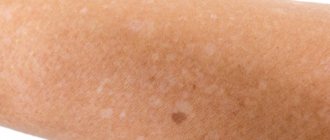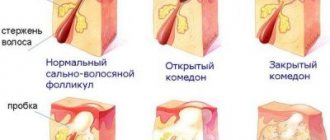Home / Articles / Why do small age spots appear on the legs?
Any changes in skin pigmentation require consultation with a specialist. The appearance of dark formations on the body can be a sign of cancer, metabolic disorders, or allergies. Depending on the reasons, treatment can be carried out by a dermatologist, cosmetologist, oncologist, endocrinologist and other doctors. But if small pigment spots appear on your legs and arms, you should start your examination by contacting a therapist. He will examine the lesions, develop a diagnostic program, and refer you to other specialists according to indications.
Causes of hyperpigmentation
The most common cause of age spots on the legs, arms, shoulders or face is exposure to ultraviolet rays. Trying to protect itself from them, the body begins to intensively produce melanin, a pigment that causes areas of the epidermis to darken.
Small dark spots on the body can also be ordinary moles (nevi). They can be congenital and appear in adulthood. The nevi themselves are safe, but they can become malignant, so if new ones appear, you should consult a specialist.
There are other causes of hyperpigmentation:
- hormonal imbalances - expectant mothers and women during menopause often complain about the appearance of dark spots;
- taking certain medications, using inappropriate cosmetics, ointments and creams - some products can increase the sensitivity of the epidermis to UV rays;
- severe liver and kidney diseases - lead to metabolic disorders and can cause changes in skin color in certain areas;
- diabetes, varicose veins and some other pathologies in which the blood supply is disrupted - pigmentation more often appears in the area of the affected tissues.
Skin pigmentation: main causes and methods of correction
A pigment spot is an area of excessive accumulation of melanin, a special pigment found in various layers of the epidermis. When it is deposited in the upper layer of the skin, small spots (for example, freckles or moles) form. They can be from light yellow to brown and, in most cases, do not cause much trouble or worry to their owner.
Hyperpigmentation, which is deposited in the deeper layers of the epidermis, looks completely different - dark brown spots appear on the surface of the skin (they can rise above the surface of the skin). Such pigmentation upsets women more, and in some cases, it really bothers them.
Age spots can appear in both young girls and women over 50. As a rule, their appearance is more likely over the age of 35-40. In isolated cases, they go away spontaneously; more often, getting rid of them requires considerable effort.
Doctors distinguish the following types of pigmentation:
- freckles;
- chloasma;
- lentigo;
- birthmarks (moles).
Reasons for increased melanin synthesis:
- Hereditary (genetic) factor. It is the result of a genetic predisposition and is usually diagnosed at birth. Severe pigmentation can be treated with modern surgical techniques (for example, laser resurfacing);
- Hormonal changes in the body. Such pigmentation can be quite noticeable and is a consequence of hormonal changes associated with the menstrual cycle, pregnancy, the postpartum period, and hormonal imbalance due to any disease. The pigmentation is called chloasma. Experts do not recommend self-treatment in this case, since it is important to accurately establish the diagnosis and conduct a course of treatment for the underlying disease;
- Mechanical damage to the skin. The formation of pigment spots as a result of attempts at illiterate treatment of acne, with chronic and severe furunculosis, due to exposure to chemical and thermal factors (burns), as well as in violation of the protocols for certain cosmetic procedures (chemical peeling, laser resurfacing, etc.). The intensity varies significantly and directly depends on many components - the characteristics of the skin of a particular patient, the degree and depth of injury;
- Aggressive exposure to ultraviolet radiation. Pigment spots of this type are provoked by aggressive exposure to sunlight or other sources of ultraviolet radiation. They often appear on the face, since the skin of this area of the body is the thinnest and most vulnerable;
- Skin aging. At a certain age (after 40-50 years and older), some people develop characteristic age spots, which are located on the face, neck, and hands. This is the result of the active synthesis of melanin and a consequence of its uneven distribution in the layers of the skin, as well as changes in hormonal balance and natural aging of the body, and the skin in particular. In addition, pigmentation at this age can be a consequence of various chronic diseases. This condition usually does not pose a danger to humans, but requires more careful monitoring of the state of health.
Other causes of pigmentation include gastrointestinal diseases and kidney pathologies, deficiency of vital vitamins or minerals, use of certain medications ( especially uncontrolled or long-term), as well as allergic manifestations due to the use of low-quality or inappropriate cosmetics and care products.
Treatment of pigmentation
The basic principle of therapy is to determine the cause and treatment adapted to this factor. You should consult with doctors:
- therapist;
- gynecologist;
- gastroenterologist;
- endocrinologist.
Special cosmetic procedures . They are performed only in specialized institutions and only by experienced professionals, otherwise serious complications are possible. The choice of technique is the prerogative of a dermatologist or cosmetologist. When choosing a treatment method, the severity of pigmentation, the location area, and the nature of the spot, its shape and size, as well as indications and contraindications for a specific method for each patient are taken into account.
The main ways to combat skin pigmentation include:
- Peeling (ultrasonic and chemical method). For the chemical method, various acids are used (azelaic, glycolic, fruit, etc.) The result of the action is the regeneration of the epidermis. When using the ultrasound method, special equipment is needed to inject various drugs into the skin. The result is skin renewal and whitening.
- A modern method is laser peeling . It is carried out using special equipment, using a laser beam to remove a layer of skin, triggering the mechanisms of its renewal and rejuvenation. The method is considered to be the most progressive and gentle, after which the list of negative complications is limited, although the method is quite traumatic and is accompanied by pain. Usually, after the procedure, it is recommended to use special healing products, and advice is given on skin care during the entire rehabilitation period and after it. Treatment should be planned in winter, since in spring and summer the skin is exposed to aggressive solar radiation and this aggravates the rehabilitation period. Laser, when used correctly, gives excellent results - rejuvenating the skin, increasing its elasticity, and acquiring a beautiful and even color.
- Phototherapy method. Light pulses are used that target only problem areas. The result is the destruction of cells containing excess melanin.
Thus, if pigment spots or other changes in skin color appear, you need to contact a dermatologist-cosmetologist. In order to find out the cause of the spots, you may need to consult another specialist (gynecologist, endocrinologist, gastroenterologist, therapist). A cosmetologist will help remove spots on the skin.
Kolova I.S.
Is it possible to get rid of small age spots on the legs?
Only a doctor can determine the cause of hyperpigmentation and assess the risks to the patient’s health. In most cases, darkening of the epidermis is a safe process. To help slow it down:
- refusal to go to the solarium,
- use of sunscreens,
- taking vitamins, minerals and antioxidants.
After consultation with a doctor, unsightly pigment spots can be lightened or removed. The specialist selects the appropriate method, taking into account the cause and type of tumor.
To exclude dangerous pathologies, if your skin color changes, make an appointment with a therapist at a clinic near the Maryino metro station. The doctor will conduct a comprehensive examination and tell you how to maintain your natural skin color.
All articles
5% discount Print coupon from our website
Ask your question on the website Get professional advice!
How do I know if I have darkening of the skin associated with varicose veins?
A pathological increase in venous pressure in the legs due to varicose veins leads to the destruction of some blood cells and the accumulation of pigment in the skin. Discoloration of the skin is first noticeable in the area of the ankles or lower third of the leg.
Skin pigmentation (darkening of the skin)
Skin pigmentation (darkening of the skin), without proper treatment, progresses, the color changes from reddish to yellow-brown or reddish-brown. The skin may then become painful, hard, and scar-like in consistency and texture. These changes indicate the transition of trophic changes to the next stage, lipodermatosclerosis. And the next stage of trophic disorders will be a venous trophic ulcer. These metamorphoses can take years or several months. Finding out what processes are associated with hyperpigmentation (darkening) of the skin is quite simple. It is enough to visit a phlebologist and perform a duplex ultrasound examination of the venous vessels of the lower extremities.
Frequently asked questions about darkening of the skin on the legs
Could darkening of the skin be associated with varicose veins in the legs?
Yes, the most common cause of darkening (hyperpigmentation) of the skin is varicose veins. These changes occur due to the accumulation of hemosiderin (a breakdown product of hemoglobin) in the skin and subcutaneous fat.
Why does darkening of the skin occur with varicose veins?
Darkening of the skin with varicose veins occurs due to prolonged stagnation of venous blood in the distal parts of the lower extremities. One of the results of this stagnation will be chronic inflammation with red blood cells leaking outside the venous vessels. Subsequently, the hemoglobin present in these cells will provide local pigmentation of the skin.
Darkening of the skin, how to deal with it?
You can effectively combat darkening of the skin due to varicose veins with the help of timely treatment of the varicose veins themselves.
How to avoid darkening of the skin?
Hyperpigmentation (darkening of the skin) can be avoided through effective treatment and prevention of varicose veins. Periodic visits to a phlebologist with duplex ultrasound scanning of the venous bed will be the best way to avoid possible darkening of the skin.










